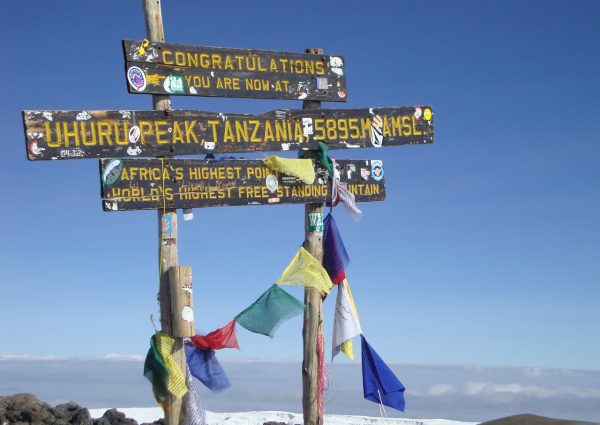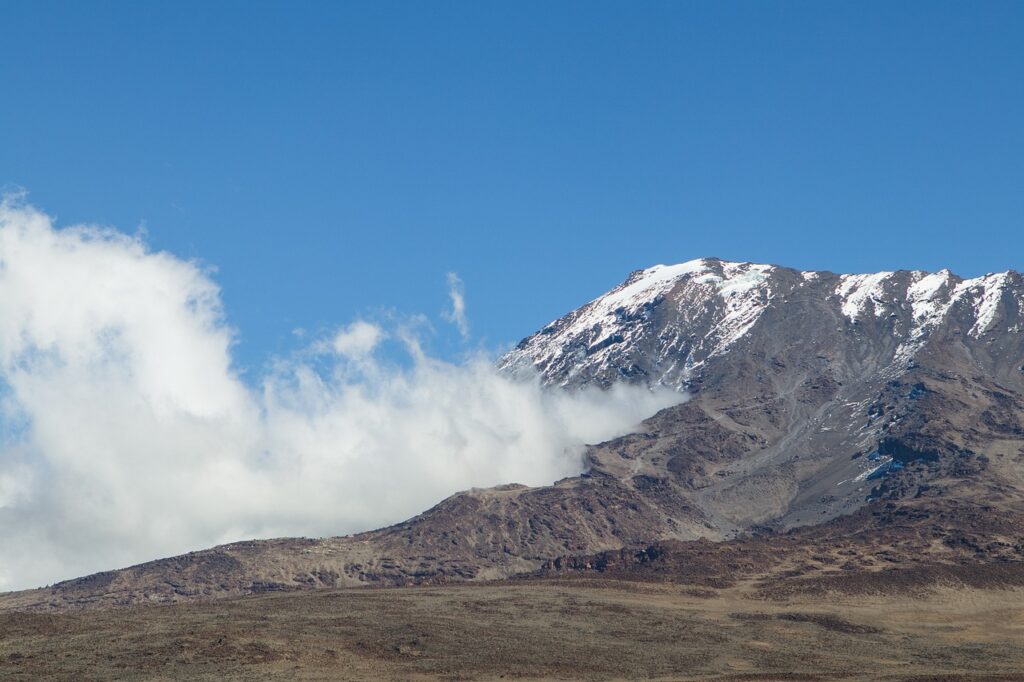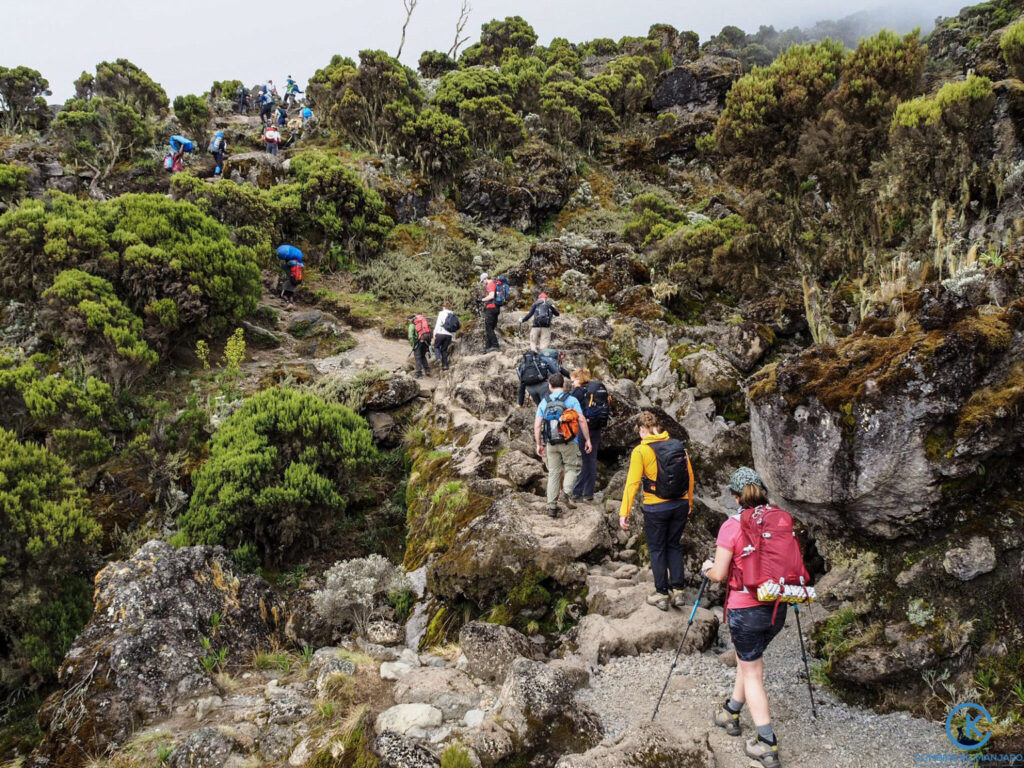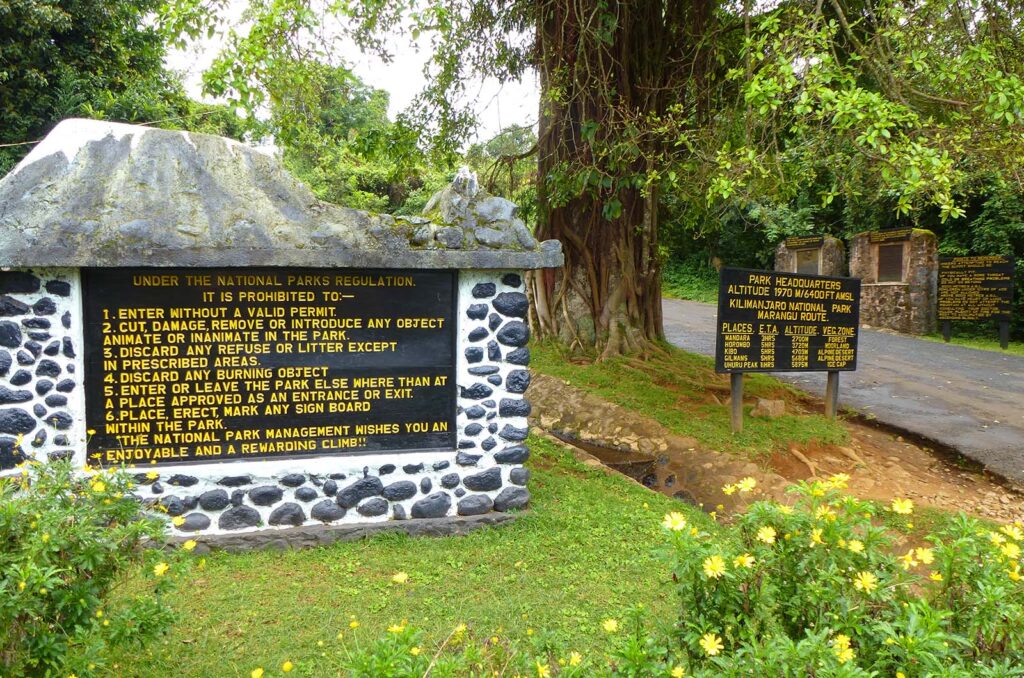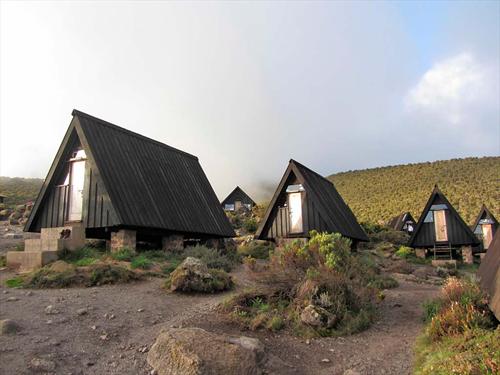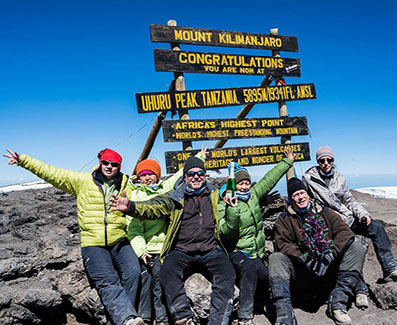7 Days Machame Route Mount Kilimanjaro Climbing
7 Days Machame Route Mount Kilimanjaro Climbing
7 Days Kilimanjaro Climb Machame Route has a 98% summit success rate because it has one extra day for acclimatization compared to 6 days Machame route climbing which has 94 percent. The six days Machame route climb will not offer you a day for acclimatization making it best for people with some hiking experience.
Known as the “Whiskey” route, the Machame route is now the most popular route on the mountain. Compared with Marangu, the days on Machame are longer and the walks are steeper. The Machame route is considered a difficult route, and is better suited for more adventurous folks and those with some hiking or backpacking experience. The route begins from the south, then heads east, traversing underneath Kilimanjaro’s southern ice field before summiting. The minimum number of days required for this route is six days, although seven days is recommended.The Machame route is scenically beautiful and varied. However, due to the heavy crowds, it loses some of its spendor.
Detailed Itinerary
Welcome to Tanzania: Meet and greet at arrival point(usually at Kilimanjaro International Airport ,JRO) by our transfer and representative driver from Nduwa Tours who will escort you to the waiting vehicle for loading your luggage then drive you to the Hotel in Arusha town. You will meet our representative who will show up at the Airport with a sign board with your name and a warm smile on his/her face when welcoming you to Tanzania. After checking in at the hotel you will get a briefing about your next day’s 9 Days Lemosho Route without Crater Camping then your mountain guide will check/inspect your climbing gears. The rest of the day can be spent relaxing at the pool or exploring the town of Arusha.
Accommodation: Mid-Range Hotel in Arusha on Bed & Breakfast Basis
The Kilimanjaro Climb Machame Route will start with a drive from Arusha to the Machame Gate takes about 1.5hrs. The journey passes through the village of Machame which is located on the lower slopes of the mountain. As we leave the park gate, we walk through the dense rain forest on a winding trail up a ridge until we reach the Machame Camp.
- Meal Plan: Lunch on route either hot lunch or packed lunch.
- Elevation : 5,380 ft to 9,350 ft
- Distance : 11 km/7 miles
- Hiking Time : 5-7 hours
- Habitat : Rain Forest
We leave the glades of the rain forest and continue on an ascending path up to a steep, rocky ridge. On the Shira Plateau, we pass through heather and open moorlands, then cross a large river gorge to Shira 2 Camp.
- Meal Plan: Lunch on route either hot lunch or packed lunch.
- Elevation : 9,350 ft to 12,500 ft
- Distance : 5 km/3 miles
- Hiking Time : 4-6 hours
- Habitat : Heath
We continue to the east up a ridge and then head southeast towards the Lava Tower – a 300 ft tall volcanic rock formation. Through the Senecio Forest, we descend down to Barranco Camp to an altitudinal level of 13,000 ft. Even if you start and end at the same altitude, it is very beneficial for acclimatization.
- Meal Plan: Lunch on route either hot lunch or packed lunch.
- Elevation : 12,500 ft to 15,190 ft
- Distance : 7 km/4 miles
- Hiking Time : 4-5 hours
- Habitat : Alpine Desert
We begin the day by descending into a ravine to the base of the Great Barranco Wall. Then we climb the non-technical but steep, nearly 900 ft cliff. From the top of the Barranco Wall we cross a series of hills and valleys until we descend sharply into Karanga Valley. One more steep climb up leads us to Karanga Camp. This is a shorter day meant for acclimatization.
- Meal Plan: Lunch on route either hot lunch or packed lunch.
- Elevation : 13,044 ft to 13,106 ft
- Distance : 5 km/3 miles
- Hiking Time : 4-5 hours
- Habitat : Alpine Desert
We leave Karanga and hit the junction which connects with the Mweka Trail. We continue up to the rocky section to Barafu Hut. At this point, you have completed the Southern Circuit, which offers views of the summit from many different angles. Here we make camp, rest and enjoy an early dinner to prepare for the summit day. The two peaks of Mawenzi and Kibo are viewable from this position.
- Meal Plan: Lunch on route either hot lunch or packed lunch.
- Elevation : 13,106 ft to 15,331 ft
- Distance : 4 km/2 miles
- Hiking Time : 4 km/2 miles
- Habitat :Alpine Desert
Very early in the morning (around midnight), we begin our push to the summit. This is the most mentally and physically challenging portion of the climb. The wind and cold at this elevation and time of day can be extreme. We ascend in the darkness for several hours while taking frequent, but short, breaks. Near Stella Point (18,900 ft), you will be rewarded with the most magnificent sunrise you are ever likely to see coming over Mawenzi Peak. Finally, we arrive at Uhuru Peak- the highest point on Mount Kilimanjaro and the continent of Africa.
From the summit, we now make our descent continuing straight down to the Mweka Hut camp site, stopping at Barafu for lunch. The trail is very rocky and can be quite hard on the knees; climbing poles are helpful. Mweka Camp is situated in the upper forest and mist or rain can be expected in the late afternoon. Later in the evening, we enjoy our last dinner on the mountain and a well-earned sleep.
Barafu Camp to Uhuru Peak
Elevation: 15,331 ft to 19,341 ft
Distance: 5 km/3 miles
Hiking Time: 7-8 hours
Habitat: Arctic
Uhuru Peak to Mweka Camp
Elevation: 19,341 ft to 10,065 ft
Distance: 12 km/7 miles
Hiking Time: 4-6 hours
Habitat: Rain Forest
On our last day of Kilimajaro Climb Machame Route, we continue the descent to Mweka Gate and collect the summit certificates. At lower elevations, it can be wet and muddy. From the gate, we continue another hour to Mweka Village. A vehicle will meet us at Mweka Village to drive us back to the hotel in Arusha.
- Meal Plan: Lunch on route either hot lunch or packed lunch.
- Elevation : 10,065 ft to 5,380 ft
- Distance : 10 km/6 miles
- Hiking Time : 3-4 hours
- Habitat : Rain Forest
The day is left free to wind down after the trek before your flight home. Depending on flight times you could go and explore Arusha town and grab some souvenirs before heading to the airport.
Price includes:
- All transfers to the mountain and back to your Arusha hotel
- Airport Transfer x2 (On Arrival & on Departure)
- Accommodation before and after Mountain Climbing
- Professional, experienced, mountain guides, potters & cooks
- Guides, Porters, Cook salaries and park fees
- All meals while on the Mountain ( Breakfast, Lunch & Dinner)
- Large portions of fresh, healthy, nutritious food
- Clean, purified drinking bottled water
- Conservation fees
- Camping fees (part of park fees)
- Rescue fees (part of park fees)
- VAT (18% charged by the Government)
- Climbing Certificate after reaching the summit
Price include
- Tanzania Visa
- Tips and gratuities (Guides, Potter & Cooks)
- Travel insurance
- Personal Expenses (e.g. laundry, telephone, beverages, etc.)
- Meals not listed in the itinerary
- Liquors, beers and bottled beverages
- Safari after Climbing
Mount Kilimanjaro Climbing Frequently Asked Questions
Kilimanjaro is climbable all year round. The best months to clim, however, are July to October and December to February, as these are the warmest and driest months respectively.
July, August and September tend to be the busiest months on the mountain.
This is an outdoor adventure trip in the African wild. There are no showers on the mountain. Warm water will be supplied in a bowl and you will be able to wash your face and hands. For the rest you can bring wet wipes.
At each campsite, we set up a private toilet tent which contains a plastic toilet. There are also simple, hole-in-the-ground public toilets (usually very dirty and not recommended).
If you need to use the bathroom on the trail, you’ll find a spot behind a tree or rock. But you’ll need to have a little baggie for putting used toilet paper in that you then carry to camp and dispose of in a bin.
Due to the great elevation gain on a Kilimanjaro climb, you will experience all kinds of weather, from 30° C (86° F) on the plains surrounding Kilimanjaro all the way down to -7 to -29° C (20° to -20° F) at the summit. So ensure you are prepared and bring the right clothing! You can learn more in Mount Kilimanjaro climate.
On the day before the Climb (arrival day) and the day after the climb (departure day), we stay in a comfortable lodge in Arusha or Moshi. It has lovely views as well as lovely rooms and facilities to match.
For the climbers who prefer Huts accommodation than camping then the Marangu route is perfect choice,the Marangu Route has three cabin lodging: Mandara Huts, Kibo Huts, and Horombo Hut. These cottage housings give cots. There are 60 bunks beds each at Mandara, Kibo.Also 120 bunk beds at Horombo Hut.
During the climb on other routes , you sleep in three-person, four-season dome-style mountain tents, two people per tent or a tent of your own, you’ll need to pay a single-person supplement.
Our tents are modern and have an outer flysheet and large vestibules where you can store your equipment during the night.
Don’t underestimate how tough Kilimanjaro is. Too many people do, and don’t make it to the top!
Depending on your current fitness, we suggest that you start your physical training at least two or three months prior to the climb. Please ask our expert to give you a guide on how should you train for Kilimanjaro? to learn more.
Remember, the fitter you are, the more enjoyable the whole experience will be for you.
We can measure each day in walking hours rather than kilometers. Most days, other than the summit day, will begin with breakfast around 6:30 AM and departure at 7 AM. You will walk four to five hours with a break for lunch followed by another hour or two of hiking in the afternoon. These days are not long or difficult and you will be advised to walk slowly.
We always have a first aid kit with us and guides are well trained on first aid. Serious injuries are very rare and Kilimanjaro National Park has a rescue team in case of emergency.
